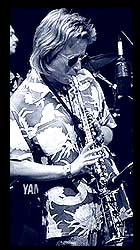
|
|
|
|
|
|
Photo Credit: Tim Owens |
Jane Ira Bloom
The legacy of women instrumentalists in jazz music is one which is often overlooked, and the list of women saxophonists is a short one indeed. But specializing as a soprano saxophonist is just a part of what makes Jane Ira Bloom so special. On this edition of Billy Taylor's Jazz at The Kennedy Center, Billy welcomes Bloom to the stage to demonstrate that she’s a truly unique musician and composer. Dr. Taylor first encountered Ms. Bloom on a panel discussion he moderated at the JazzTimes magazine convention, which featured women describing their various experiences in becoming established jazz musicians. In spite of many trials and tribulations, a common theme of that discussion, Dr. Taylor was impressed at the independent spirit of Jane Ira Bloom. "She kicked the door down," is Billy's very apt summation of her determination in advancing her career. This independent spirit is a key element of Jane Ira Bloom's music. Bloom combines her original approach with a strong working knowledge of the history of jazz music and an appreciation for the standard song form. Bloom's insight into the standard jazz repertoire, coupled with her spirit of adventure and original expression, is exhibited early on in the program when she joins Dr. Taylor's trio for a rendition of the familiar "My Favorite Things". Bloom's arrangement alters the original harmonies of the familiar song, which John Coltrane first popularized on soprano saxophone. Born and raised in Boston, Bloom’s musical development began on the piano, followed by some experimentation with the drums. She then switched to the alto saxophone, which led inevitably, it seems, to the soprano sax. According to Jane she really didn't become serious about playing the sax until she began studying music at Yale, where she achieved a liberal arts degree and a Master's degree in music. She is quick to point out to the audience that she really "didn't learn to play the saxophone" at Yale, but developed her ideas about music and composition there. Like many aspiring jazz musicians, Bloom wound up in New York City after Yale. She became involved in the so-called loft jazz scene in downtown Manhattan—old warehouse spaces where various types of artists congregated and musicians performed. Here Bloom found an adventurous environment that nurtured free expression and original composition. One of her initial musical encounters was with the cutting edge vocalist-educator Jay Clayton, whom she played with at various lofts in lower Manhattan. When Dr. Taylor asks Jane about her musical inspirations , she points to individualists like trumpeter Booker Little, "his voice means a lot to me," as well as such iconoclasts as saxophonists Sonny Rollins and Ornette Coleman. Asked how she approaches music, Jane responds "With a singular voice, a voice that you can't confuse with anybody else." This singularity of sound is illustrated throughout the program, but nowhere as vividly as when she plays her interpretation of "Body and Soul," a tune which became a jazz standard with saxophonist Coleman Hawkins' memorable version. Bloom's "Body and Soul" is a decidedly original re-structuring of the song that she calls "Hawkins' Parallel Universe." More recently, Bloom has been experimenting with what she calls " live electronics", whereby she utilizes an electronic set-up onstage. She alters her sound via a foot-pedal triggered device that engages various electronic effects, at times creating almost an orchestra of soprano saxes. Such devices also serve to further broaden Bloom's creative pallet, as she demonstrates for the Kennedy Center audience. This leads inevitably to a discussion of Bloom's very unique commission to compose an original piece of music for NASA, the first musician to write for the agency’s arts program.
Bloom comes back full circle from these original ideas to conclude the program with a piece of music written by one of her abiding musical influences, Sonny Rollins' jazz standard "Oleo."
|
|
| |
